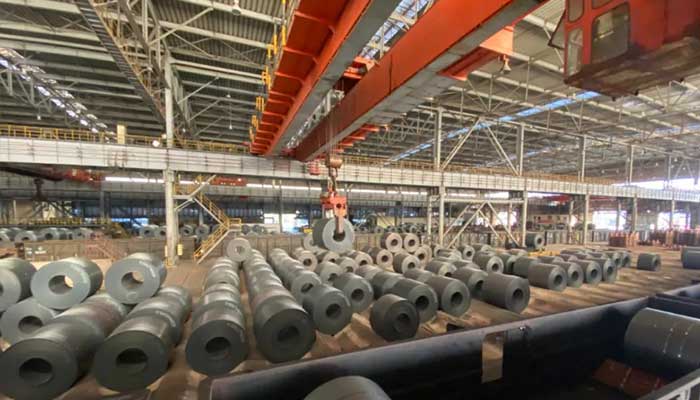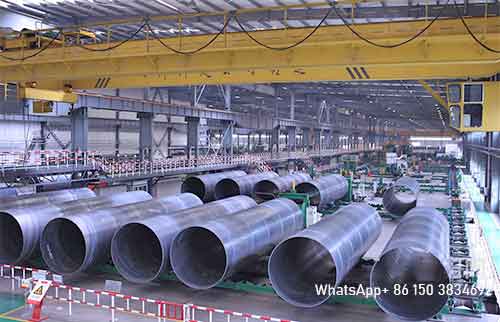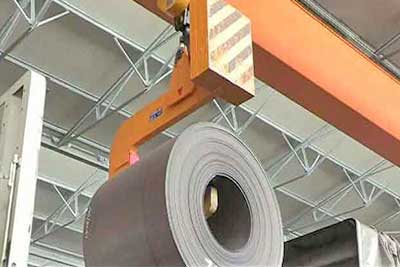Overhead Cranes in Raw Material Storage in Metal Working
Overhead Cranes in Raw Material Storage in Metal Working
Raw material storage stands as the backbone of numerous industrial processes, and the efficient management of these materials is critical for seamless operations. In the vast landscape of storage yards and warehouses, the utilization of overhead cranes emerges as a pivotal factor in enhancing material handling efficiency and organizational structure.
Overhead cranes are robust and versatile mechanical systems specifically engineered to lift, transport, and position heavy loads within storage yards and warehouses. These cranes, suspended from elevated runways, provide an elevated advantage, enabling precise and efficient movement of raw materials throughout the storage area.
Efficient material handling in storage yards is a linchpin in maintaining a streamlined workflow. Whether it's steel coils, industrial components, or various raw materials, effective handling and storage mechanisms are essential. The significance of overhead cranes in this domain cannot be overstated, as they significantly contribute to the seamless movement and arrangement of materials, ensuring an organized and optimized storage layout.
Functions of Overhead Cranes in Raw Material Storage
Handling and Management of Diverse Raw Materials
Raw materials within storage yards encompass a wide spectrum, ranging from steel coils to heavy machinery components. The versatility of overhead cranes plays a pivotal role in effectively managing this diversity. These cranes, with their adaptable configurations and varying tonnages, cater to the specific needs of each raw material type.
Steel coils, for instance, present unique challenges due to their substantial weight and cylindrical shape. Overhead cranes designed for coil handling are equipped with specialized attachments, ensuring secure gripping and precise movement. Similarly, cranes adapted for handling other materials like billets, tubes, or machined parts are customized to handle their distinct shapes and sizes with ease.
Facilitating Organization and Accessibility
An efficiently organized storage yard directly translates into enhanced accessibility and workflow efficiency. Overhead cranes contribute significantly to this aspect by streamlining the arrangement of raw materials. They enable the systematic placement of materials in designated areas, ensuring accessibility when needed for production or processing.
By employing cranes with the appropriate lifting capacities and reach, materials can be easily accessed and moved within the storage area. This strategic organization not only enhances accessibility but also minimizes the time and effort required for locating and retrieving specific raw materials.
Double girder overhead crane for steel coil handling
Raw Material Types and Specific Tonnages
Steel Coil Storage Cranes
Steel coils are a fundamental component in many metalworking industries, but their storage and handling pose distinct challenges due to their weight and unique cylindrical structure. Overhead cranes designed explicitly for steel coil handling are equipped with specialized attachments to ensure safe lifting and precise movement. These cranes boast varying tonnages tailored to accommodate different coil sizes and weights.
The specific tonnages for steel coil storage cranes typically range between 30 tons, 40 tons, and can extend up to 60 tons or more, depending on the dimensions and weight-bearing capacity of the coils. These cranes' robust design and tailored lifting capacities enable the efficient storage and retrieval of steel coils within warehouses or storage yards.
Other Raw Material Categories and Corresponding Capacities
Aside from steel coils, the diverse nature of raw materials in metalworking necessitates specialized handling mechanisms within storage yards. Cranes engineered for materials like billets, tubes, machined parts, or heavy machinery components are specifically designed with varying tonnages to suit the unique characteristics of each material category.
Cranes for Handling Billets and Tubes
Cranes designated for billet storage or tube handling typically encompass tonnages ranging from 20 tons to 40 tons. These tonnage capacities are meticulously determined to accommodate the specific dimensions and weights of billets and tubes commonly utilized in metalworking operations. The design precision ensures efficient and safe handling while optimizing storage space within the facility.
Handling Heavy Machinery Components
For handling heavy machinery components, specialized cranes are required with higher load-bearing capacities. These cranes are engineered to handle loads starting from 50 tons, scaling up to 80 tons or higher, based on the varying dimensions and weights of heavy machinery components encountered in industrial settings. The robust design and tailored capacities of these cranes ensure safe and reliable material handling of these sizable components.
Precise Tonnages for Enhanced Material Handling
The precise tonnages allocated for each raw material category are meticulously calculated based on thorough assessments of material dimensions, weights, and handling requirements. These calculations ensure that the cranes deployed within the storage facility possess the necessary load-bearing capacities to handle materials effectively and safely.
Pipe and tube handling overhead crane
Calculating Precise Tonnages for Optimal Material Handling
Determining the precise tonnages allocated for each raw material category involves a comprehensive evaluation that encompasses several crucial factors. These calculations are the cornerstone of ensuring that overhead cranes possess the necessary load-bearing capacities to handle materials both effectively and safely within storage yards or warehouses.
Material Dimensions and Weights Assessment
Thorough assessments of the dimensions and weights of raw materials form the initial stage of determining crane tonnages. This involves precise measurements and analysis of the varying sizes, shapes, and weights of materials like billets, tubes, heavy machinery components, or other raw material categories commonly used in metalworking.
Handling Requirements Evaluation
Understanding the specific handling requirements of different materials is equally vital. Some materials may demand more intricate lifting procedures, require careful precision during placement, or need swift and controlled movements. These handling requirements directly influence the necessary crane capacities to ensure seamless material handling.
Tailored Crane Capacities for Enhanced Efficiency
Employing overhead cranes with precisely tailored tonnages for distinct raw material categories empowers metalworking facilities to optimize their material handling operations. These tailored capacities directly cater to the unique characteristics of each material, ensuring that cranes can lift, move, and position materials effectively and safely.
Benefits of Tailored Tonnages
The utilization of overhead cranes equipped with tailored tonnages results in numerous operational benefits. Efficient workflow, minimized handling times, and a safe operational environment are the direct outcomes of utilizing cranes with capacities precisely matched to the materials being handled. These optimizations lead to enhanced productivity and safety within the metalworking facility.
By employing this meticulous approach in calculating and deploying overhead cranes with tailored tonnages for different raw material categories, metalworking facilities can significantly improve their material handling efficiency and ensure a secure operational environment.
Design Features of Cranes for Raw Material Storage
Cranes employed in raw material storage undergo meticulous design adaptations to suit the unique demands of material handling within storage yards or warehouses. Their configurations are tailored with precision to maximize functionality and efficiency in these specific environments.
These cranes often feature adjustable heights, versatile spanning capabilities, and maneuverability to navigate through the storage area efficiently. Additionally, they are designed to operate seamlessly in confined spaces while maintaining robust structural integrity.
The structures of these cranes are engineered to withstand heavy loads and extended operational hours. Built with durable materials and reinforced frameworks, they ensure reliability and longevity, essential for continuous material handling in storage facilities.
Tailored Configurations for Enhanced Flexibility
The configurations of these cranes are specifically tailored to ensure maximum adaptability and efficiency in material handling within storage facilities. They feature adjustable heights that facilitate the lifting and positioning of materials at varying elevations. Moreover, their versatile spanning capabilities enable them to cover a wide area within the storage yard or warehouse, ensuring comprehensive material coverage.
Maneuverability and Adaptability in Confined Spaces
These cranes are engineered for maneuverability, allowing them to navigate through confined spaces within the storage area with ease. Their design incorporates features that enable precise movement, even in areas with limited clearance. This adaptability ensures that materials can be accessed and handled efficiently, regardless of spatial constraints within the storage facility.
Structural Robustness and Durability
The structural integrity of these cranes is paramount for sustained, heavy-duty performance in raw material storage operations. They are constructed using robust materials and reinforced frameworks capable of withstanding heavy loads and prolonged operational hours. This durability ensures reliability and longevity, crucial for continuous and uninterrupted material handling operations in storage facilities.
Efficiency and Reliability in Material Handling
The design adaptations made for these cranes are aimed at optimizing their efficiency and reliability within the storage environment. By incorporating adjustable configurations, maneuverability in confined spaces, and robust structural elements, these cranes facilitate seamless material handling, enhancing overall operational efficiency within the storage yard or warehouse.
Load Handling Mechanisms Tailored for Specific Raw Material Types
The design and functionality of cranes used in raw material storage facilities are carefully crafted to accommodate the unique characteristics of diverse raw materials. These cranes feature specialized load handling mechanisms that are precisely tailored to ensure the safe and efficient handling of different types of raw materials commonly found in metalworking environments.
c hook
Specialized Attachments for Secure Handling
Cranes utilized in the storage of steel coils, billets, or heavy machinery components are equipped with specially designed attachments, hooks, or lifting devices. These customized mechanisms are engineered to provide a secure grip and precise handling of the specific raw material types they are intended for.
For instance, cranes employed in steel coil storage yards are equipped with coil hooks or specially designed clamps that securely grasp the cylindrical shape of the coils. These attachments are meticulously engineered to prevent slippage or damage during the lifting and movement of steel coils, ensuring safe handling and placement.
Tailored Designs for Optimal Efficiency
The load handling mechanisms incorporated into these cranes are designed to optimize efficiency and safety while accommodating the unique shapes, sizes, and weights of various raw materials. For different types of materials such as billets, tubes, or heavy machinery components, these cranes feature custom-designed attachments specifically optimized to securely handle and position these materials.
Precision and Damage Prevention
The specialized attachments and lifting devices are engineered to ensure precision handling without causing any damage to the raw materials. By securely grasping and supporting the materials with tailored load handling mechanisms, these cranes prevent shifting, slippage, or accidental damage during lifting, transport, and placement operations.
Enhanced Safety and Operational Efficiency
The integration of custom load handling mechanisms into these cranes contributes significantly to enhanced safety and operational efficiency within the storage facility. These mechanisms enable seamless and secure handling of diverse raw materials, ensuring precision and minimizing the risk of accidents or material damage during handling operations.
Benefits and Efficiency in Raw Material Management
Optimized Space Utilization and Organization
One of the pivotal advantages of employing overhead cranes in raw material storage is their ability to optimize space utilization and facilitate organized storage layouts. These cranes, designed with adaptability and precision, play a crucial role in maximizing storage capacity within confined spaces while ensuring easy access to stored materials.
By utilizing overhead space efficiently, these cranes enable vertical stacking of materials, effectively increasing storage capacity without expanding the storage area horizontally. This vertical storage strategy not only conserves valuable floor space but also enhances the overall organization within the storage yard or warehouse.
Enhanced Workflow and Reduced Material Handling Times
Efficiency in material handling is paramount in any industrial setting, and overhead cranes significantly contribute to streamlining workflow processes. These cranes expedite material movement, enabling swift and precise transfers of raw materials from storage to production areas.
With their ability to lift and transport heavy loads swiftly and efficiently, overhead cranes minimize material handling times, consequently optimizing the overall production workflow. Reduced handling times translate to increased operational efficiency and productivity within the facility.
The strategic organization and expedited material handling facilitated by overhead cranes not only enhance workflow but also contribute to cost savings and improved operational throughput.
Safety Measures in Raw Material Storage Operations
Safety Protocols for Crane Operations in Storage Yards
Safety stands as a paramount concern in the operation of overhead cranes within storage yards or warehouses. Rigorous safety protocols and operational guidelines are implemented to ensure the well-being of personnel and the protection of materials.
Comprehensive training programs for crane operators emphasize adherence to safety procedures, encompassing proper load handling, awareness of surroundings, and utilization of safety devices. Routine inspections and maintenance checks are also conducted to ensure that cranes are in optimal working condition, minimizing the risk of malfunctions.
Additionally, safety features such as emergency braking systems, overload sensors, and proximity detectors are integrated into the crane systems. These safety mechanisms serve as fail-safes, mitigating potential risks and enhancing operational safety during material handling activities.
Ensuring Safety Compliance and Accident Prevention
Adherence to safety regulations and industry standards is imperative in storage yard operations involving overhead cranes. Compliance with safety protocols established by regulatory authorities ensures that safety measures are systematically implemented and adhered to within the facility.
Regular safety audits and assessments are conducted to evaluate the efficacy of safety measures and identify areas for improvement. This proactive approach aids in continuously enhancing safety protocols and prevents potential accidents or hazards that may arise during material handling operations.
By prioritizing safety compliance and implementing stringent safety measures, storage yards and warehouses employing overhead cranes mitigate risks and maintain a safe working environment for all personnel involved in material handling activities.
In conclusion, the utilization of overhead cranes in raw material storage operations stands as a testament to their pivotal role in modern industrial settings. These crane systems, meticulously designed and tailored for specific material handling requirements, revolutionize the way raw materials are stored, accessed, and utilized within warehouses and storage yards.
Overhead cranes, such as those adapted for steel coil handling or heavy machinery component storage, demonstrate unparalleled efficiency in optimizing space utilization, streamlining workflow, and enhancing accessibility to stored materials. Their adaptability, precision, and safety features contribute significantly to the overall productivity and operational effectiveness of metalworking facilities.
Emphasizing Improved Efficiency, Safety, and Organizational Benefits
The implementation of overhead crane systems brings forth a multitude of benefits, including heightened operational efficiency, reduced material handling times, and organized storage layouts. Moreover, stringent adherence to safety protocols and compliance with industry standards ensure a safe working environment for personnel involved in material handling operations.
Additionally, the strategic integration of advanced technologies, coupled with tailored design features, facilitates improved safety, workflow efficiency, and overall organizational benefits within raw material storage facilities.




